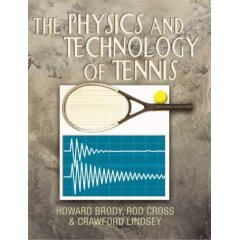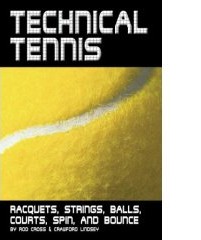March 2006 Article Turbo Tennis Archives:
Tennis Server
|

 |
Here we are in March. In like a lion and out like a lamb for those of us north of the equator. Typically, some of my readers will resurrect their racquets and gear about this time of year in anticipation of the outdoor season to come. In other cases, the year-round player is making some decisions with respect to new equipment. Invariably, I get lots of technical and scientific-oriented questions at this time of year in my e-mails. It is not surprising. The racquet manufacturers make a major effort to induce players to consider new gear as the warmer weather approaches. With all of the "innovations" that arrive each year, it is easy to see why readers become confused. Well, this month’s column is going to be dedicated to helping you separate fact from fiction regarding many of the claims that appear in tennis ads. I rarely, if ever, plug any specific reference or reading material, but in this case there are two books that I highly recommend reading. It would be less than honest of me, if I did not acknowledge that I have contributed photos to each of these books. That being said, I still believe that these two works are absolutely required reading for the tennisphile. The two books are: The Physics and Technology of Tennis and the recently released, Technical Tennis: Racquets, Strings, Balls, Courts, Spin, and Bounce. Both books are published by the United States Racquet Stringers Association, which has a web site at RacquetTech.com. The former of these two books is the most comprehensive work on the physics of the game that I have ever encountered. The latter is a book that is a bit less ambitious, but provides extremely clear answers to the most frequently asked questions associated with tennis technology. Let’s face it. Once wood racquets disappeared from the game, technology became increasingly important. Over the years, we have seen graphite, wide body, long body, double string bed, and myriad other racquets emerge. Each claims to revolutionize the technology of hitting the yellow fuzzy ball. In all honesty, my opinion is that racquet manufacturers struggle to find "new" and "unique" aspects to incorporate into their new lines of racquets. Sometimes, the change is simply cosmetic. The goal? To sell racquets. Out with the old and in with the new. Subconsciously, I believe we fall victim to the belief that a new racquet will correct all those errant shots we hit or give us the overwhelming power to beat any opponent. I wish it were that simple. It is true that a racquet can be better suited to one’s game. But, I know of no panaceas when it comes to playing competitively. If I did, I would be on the ATP tour!!! A few facts should be kept in mind. After awhile, any racquet becomes a little "dead." The constant "bending" of the frame over time takes its toll. If you are using a single frame all of the time (instead of having several of the same frames which you alternate in play), you will find this racquet becomes "dead" more quickly. Rod Laver is quoted as having said that "Grip is everything." Well, racquet grips (even when using an over grip) eventually wear out and begin to lose shape. By far, the most tenuous part of a racquet is its strings. Frankly, I think we all try to get a little too much life out of our strings. Over time, strings change in terms of their properties. This is true even when they are not being used and stored away during the winter months. Invariably, you are going to need a racquet restrung…if only because a string breaks. My thinking? If you are restringing because a string broke, you have been playing with the strings too long in the first place. I am a firm believer in having a USRSA certified technician string my frames. I can and have strung my own racquets. I have had the "club stringer" string frames in a pinch. Although my experience is anecdotal, I have found that when my frames are strung by a USRSA technician, they play better and play longer. I am fortunate to have the services of Chris Gauidreau at the New Haven branch of the Racquet KOOP. Chris is a USRSA Master Racquet Technician and literally strings the racquets for pros on both tours at Newport, and the Pilot Pen. I have never known Chris not to take the time to really help any customer find the right racquet, string and tension combination. His approach is not just about sales; rather it is about service and customer satisfaction. My entire collegiate team has their racquets strung, balanced and re-gripped by Chris every season. The USRSA will be able to locate a certified technician near you. Believe me, the large sporting good chains do not have the personnel that possess the same knowledge and concern as do USRSA members. The most important ingredient apart from professional advice in selecting a racquet is play testing various frames. You wouldn’t buy a car without a test drive. In a sense, it is more foolish to buy a racquet frame without first testing it. Most tennis shops have demo programs that are free or require minimal cost. By learning what doesn’t feel right, the USRSA expert can better guide you to a frame that is right. It never ceases to amaze me when I see experienced players change grip size. Frankly, most people think my grip size (4 3/8 or Level 3) is too small for my hand. Still, with modern frames, I can use a smaller grip and not have to worry about racquet frame twisting or torque. I find that the smaller grip aids in my volleys and serves. My groundstrokes are my strength, but the smaller than normal grip doesn’t hurt these at all. How did I realize this? By play testing a frame from the Racquet KOOP which was equipped with a 4 3/8 grip. Different manufacturers of frames have different "shapes" to their grips…despite the overall circumference being the same. Some feel more square than others. Again, the USRSA technician can advise you about what shapes are associated with what manufacturers of frames. There is no point in getting a somewhat thinner and elongated grip, if your preference is for a more square grip feel. By far, strings are the most variable aspect in racquet technology today. I spend the extra money on natural gut. I like the feel and power of these strings. They also seem to help my arm and shoulder suffer fewer aches and pains when I am playing a lot. Synthetic strings are more affordable. But, each has its own set of characteristics. (By the way, I always have one frame strung with synthetic gut because moisture and the calcium used on clay courts can weather natural gut causing a premature breakage. Again, I learned of this tip from Chris.) With so many strings available, which is right for you? A USRSA technician will help you find the right answer more quickly, I assure you. People often write and ask me what frame do I use. I never give them an answer. Rather, I suggest that they forget about who uses any frame…pros included. The important thing is what frame works for you!!! Although there are standards for "legal" tennis balls, not all balls are the same. What really makes for a fast or slow surface? What characteristics does a particular ball possess and what surface(s) is best suited to this ball’s characteristics? If you could truly hit with the heavy European balls that are part of the clay court surface, you would immediately see the difference. Hitting these balls seems like hitting a ball that is twice as heavy (not to worry…it isn’t). Tennis is not a game of inches. It is a game of milliseconds, and millimeters. This is why the pros have their racquets customized to make them all identical. Believe me. Andre Agassi would not change racquets at every ball change (as did Ivan Lendl) if the frames were not identical. Again, the USRSA Master Technician can make two frames feel and play identically. Can your large sports chain tennis department do this? So, I write this article with several intents. First, you are right to re-evaluate your gear. If nothing else, spring for new strings and grips. Second, I strongly recommend either or both of these wonderful books: Reading these books will help you gain the knowledge to separate fact from fiction. More important, they may help you understand what happens when you hit that ball and why. Knowledge is power in this game. Lastly, I cannot begin to encourage you enough with respect to finding and using a USRSA certified technician. Their training and skills, coupled with the aforementioned books' knowledge, will go a long way toward making you the tennis overdog that you are meant to be.
1996 - 2002 | 2003 - Present
This column
is copyrighted by Ron Waite, all rights reserved. Questions and comments
about these columns can be directed to Ron by using this form.
Ron Waite is a certified USPTR tennis instructor who took up the game
of tennis at the age of 39. Frustrated with conventional tennis methods
of instruction and the confusing data available on how to learn the
game, Ron has sought to sift fact from fiction. In his seven years of
tennis, Ron has received USTA sectional ranking four years, has successfully
coached several NCAA Division III men's and women's tennis teams to
post season competition, and has competed in USTA National singles tournaments.
Ron has trained at a number of tennis academies and with many of the
game's leading instructors.
In addition to his full-time work as a professor at Albertus Magnus
College, Ron photographs ATP tour events for a variety of organizations
and publications. The name of his column, TurboTennis, stems from his
methods to decrease the amount of time it takes to learn and master
the game of tennis.
|



October 2022 Tennis Anyone: Patterns in Doubles by John Mills. September 2022 Tennis Anyone: Short Court by John Mills. |
 You will join 13,000 other subscribers in receiving news of updates to the Tennis Server along with monthly tennis tips from tennis pro Tom Veneziano.
You will join 13,000 other subscribers in receiving news of updates to the Tennis Server along with monthly tennis tips from tennis pro Tom Veneziano. 

